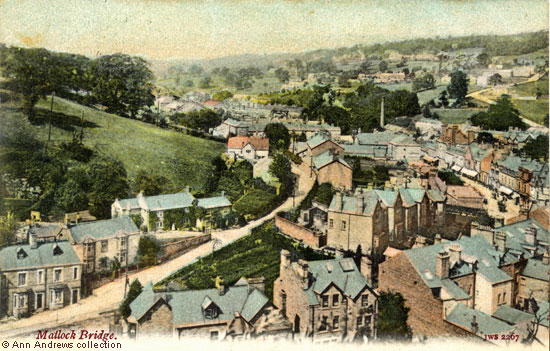|
Images Index> Matlock, 20th and 21stC Images> This page |
| Matlock: Holt Lane and Dale Road, about 1900 |
| Matlock : Twentieth Century Photographs, Postcards, Engravings & Etchings |
|
|||
Thomas Green had been the landlord of the Rock Inn for 55 years in 1902 when he was presented with a silver mounted oak walking stick at a supper given in his honour by the committee of the Matlock Property Owners' and Ratepayers' Association[2]. By 1908, when he was 97, he been associated with the licensing trade for a longer period than anyone else[2]. He was born at Allestree on 20 June 1812 and began his working life as a gardener at the Darley Abbey home of Mr Samuel Evans, the banker, before becoming the under gardener to Mr. Arkwright in 1830. After his marriage he started a small beer house in Hackney Lane but moved to Holt Lane in September 1845, obtaining a beer licence for the Rock Inn in 1864. Running the Inn wasn't his only job as for many years was also the Manager for David Wheatcroft of Hopton Stone Quarries and afterwards for Mr S J Claye of Long Eaton Ironworks at the Long Tor Stone Quarry, Matlock Dale[4]. He didn't quite make his century, dying in 1911, aged 99. We learn of some of the other Holt Lane residents and businesses from a 1903 sale notice of Holt Lane copyhold property belonging to the Manor of Matlock[5]. The first Lot consisted of three cottages, with yards and an adjoining garden, that were occupied by Arthur Young, William Carney and Edward Hadkin[6]. The second Lot was made up of three brick built dwelling houses with slate roofs and a stone built dwelling house used by Mr Richard Hilton, the Crown Square tailor and outfitter, as a workshop. There was also a croft of grass land occupied by Messrs. William Warr, W. Dakin, R. Hilton, A. Keeling, H. Tollady and others[6]. At the far end of Dale Road is a stone built mill with a tall chimney which was used as a colour works in 1893[7]. |
|||
|
"Matlock Bridge". JWS [J. Welch & Sons, Portsmouth], No.2206. Posted on 19 Aug 1905 at Leeds. Message, but not relevant to the image. Postcard in the collection of and provided by, researched by and © Ann Andrews. Intended for personal use only |
|||
References (coloured links are to transcripts or more information elsewhere on this web site): [1] With thanks to Colin Goodwyn for this information. [2] "Derbyshire Times and Chesterfield Herald", 28 June 1902. Presentation to a Nonagenarian. [3] "Derby Daily Telegraph", 4 September 1908. [4] "Derby Daily Telegraph", 19 June 1909. Thomas Green talked about his life. He had married Lydia, daughter of Henry Roper of the Ashes, Cromford at St. Giles' in 1842.His is listed in Matlock and Matlock Bath census returns: he was in Matlock Bath the 1841 census | on Holt Lane in the 1851 census | the 1861 census | the 1871 census | the 1881 census | the 1891 census | the 1901 census. [5] "Derbyshire Times and Chesterfield Herald", 18 July 1903. Sale of property on Holt Lane by Messrs J. Else and son. These properties were bounded by Holt Lane itself, and the properties of the Midland Railway Company, Messrs Geo. R Platts and Geo Gregory. [6] We can find most of these people living on Holt Lane in the 1901 census. Mr. Young lived next door to the Common Lodging House and Messrs. Warr, Carney and Hadkin [Atkins in the sale notice] lived a bit further along the road. Arthur Keeling was at Sherwood House on Holt Lane whereas Mr. Tollady lived on Matlock Bank. [7] 1893 auction notice. There are several other images of the former colour works and its chimney on the
site: The Popular Album of Matlock is a late 19th century booklet and the chimney is coloured red
on Matlock - looking towards Hackney, early 20th Century. You have to
look hard, but it also can be seen on Matlock Bank and Bridge, 1900-02 (second image) and
Matlock Bank, the Hall Leys and Dale Road, 1912-14 (top image). |




